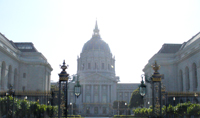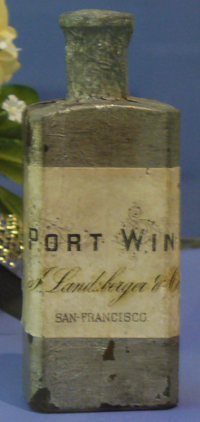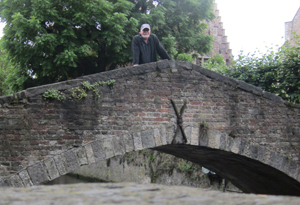the traveler must possess
fixed interests and facilities
to be served by travel.
Travel Index:
San Francisco, California 2009
Early California wine
country and the role of Isidor Landsberger

San Francisco City Hall
In 1872, a cornerstone was sealed and installed in San Francisco's City Hall. Four bottles were included: one of grain, of Baker's extra flour, of Champaign,
 and
this vintage bottle of port wine by I. Landsberger (no relation?) &
Co.
and
this vintage bottle of port wine by I. Landsberger (no relation?) &
Co.
In 1856 Agoston Haraszthy (Haraszthy Ágoston), Hungarian by birth, moved to Sonoma, about fifty miles north of San Francisco, and bought a small vineyard northeast of the town and renamed it Buena Vista. He moved his vines there from his original location in Crystal Springs and expanded his vineyards. In 1857, he began to bore tunnels into the sides of a nearby mountain and build stone cellars at their entrance. He eventually had two large stone winery buildings, equipped with underground tunnels and the latest wine-making equipment in California. Haraszthy’s cellars at Buena Vista were the first stone wineries in the state. He added acreage to his original purchase, eventually holding more than 5,000 acres (20 km2) of valley and hillside. He was a proponent of hillside plantings, arguing that vines should be permitted to grow without irrigation. He divided some of his acreage into smaller plots, inducing prominent Californians to come to Sonoma, where he planted vineyards for them. He was a vocal advocate of Chinese immigration, arguing that Chinese should be permitted to come to California and provide much-needed labor. He built a Pompeian-style villa in the middle of the Buena Vista vineyards, in which he lived with his family.
On April 23, 1862, he was elected president of the California State Agricultural Society, recognized as California’s leading winemaker. He contributed articles to newspapers and made speeches to gatherings of agriculturalists. He entered his wines in the competition of the California State Fair and received the highest awards. However, in 1863 his focus changed from developing and promoting small independent wine farms and sold his lands, vineyards, and winery to an organization called the Buena Vista Vinicultural Society (BVVS). The society, incorporated in April, had a variety of purposes: to develop land, to quarry stone, etc. but its main aim was to become the biggest winemaker in California, and soon Haraszthy himself, who held 2,600 of the society's 6,000 shares, was a trustee and the superintendent of the firm. He was joined by such winegrowing Sonoma neighbors as Isidor Landsberger, Emil Dresel, and Major Jacob Snyder. The crucial backing, though, was provided by the William J. Ralston, lord of the Comstock Lode and builder of San Francisco's Palace Hotel. In 1864, an article in Harper's Magazine proclaimed that Buena Vista was “the largest establishment of the kind in the world.”
It began manufacturing sparkling wines with the assistance of experienced workmen from Epernay and Aywith various success, and often the majority the wine had to be emptied from the bottles and distilled into brandy. Haraszthy borrowed large sums of money to expand the vineyards and cellars of BVVS. The Massachusetts editor Samuel Bowles visited in 1865 and was not impressed. It did not, he said, seem "well managed" nor, "do we find the wines very inviting .... I have drank, indeed, much better California wine in Springfield than out here." In short, the Buena Vista venture was not paying dividends, and Haraszthy, the central figure, quickly came under fire from stockholders.
His use of layering as a planting technique, while resulting in quicker propagation of vines, also exposed the plants to soil diseases. By the middle of the 1860s, the vines at Buena Vista were growing brown and weak. Haraszthy’s critics believed this was due to his layering, but it was the result of the first infestation of the phylloxera ever known in California which quickly spread throughout the California and even crossed the Atlantic to France where it caused devastation. With production lagging, profits from Buena Vista wine were inadequate to pay the Society’s debt. There was a scandal in 1864 about an attempt to defraud by distilling "brandy" from molasses brought in from the Sandwich Islands. In 1866 or 67, Haraszthy resigned his position and was replaced with Isidor Landsberger who tore out the layered vines. Haraszthy left Buena Vista for another vineyard in Sonoma owned by his wife, and while living there filed bankruptcy.
Landsberger, an original trustee of BVVS, severed ties when Ralston and investors took control of BVVS. In late 1865 he also organized the firm of I Landsberger and Co. which operated out of a complex of brick buildings on Jackson Street in San Francisco. He was the senior partner and Arpad Haraszthy was the principal wine and champagne maker. They discovered the causes of the problems, and for ten years constantly improved quality owing to the increased use of foreign grapes, which yielded a vin brut with a delicate bouquet and flavor approaching in character to the finer champagnes. Sonoma valley vineyards now produced the lightest wines California, “some 211 of the white varieties indicating merely 15° of proof spirit, and the red ones no more than 17½°.” The operation was based on the French and German model, purchasing wine of a certain quality and standard from the growers, and then preparing it for the market , a practice in the wine-growing districts of France and Germany. Landsberger was making a name in sparkling California wines, ranked with some of the best European vintages, and cheaper to produce costing half of imported wines. Strange to say, notwithstanding all these recommendations the chief market for Californian wines is not the State of California. They are readily purchased in Chicago and New York, while in San Francisco they are not half so popular as the more expensive, but not better wines which have been brought from Europe, and which are sold at a high price.
Bibliography:
Vizetelly, Henry, Facts About Champagne and Other Sparkling Wines, Project Gutenberg ebook, March 24, 2007 [EBook #20889]
Pinney, Thomas, A History of Wine in America, From the Beginnings To Prohibition, University of California Press, Berkeley · Los Angeles · Oxford, © 1989 The Regents of the University of California
Rae, William Fraser, Westward by Rail: A Journey to San Francisco and back and a Visit to the Mormons, Bernhard Tauchnitz Publisher, Leipzig,1874.
Wikipedia: http://en.wikipedia.org/wiki/Agoston_Haraszthy, accessed June 2, 2009.
From Wine
Files.org keyword search on "Landsberger" --Isidor, (1824 -1904)
30 Records, beginning 1867-11-09
San Francisco, California 2009
California's Proposition 8: the rally the day of
the Calif. Supreme Court ruling, May 27, 2009 Photos that
speak for themselves:
